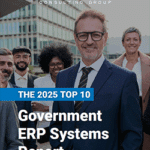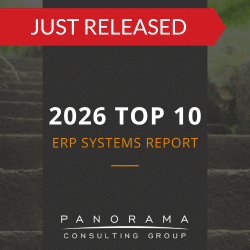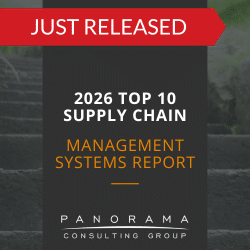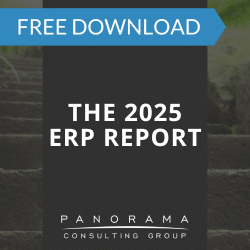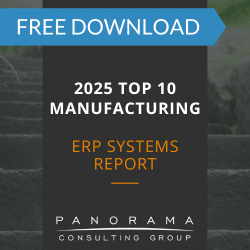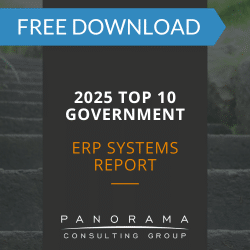- Business strategy should guide ERP selection to ensure technology aligns with long-term goals.
- ERP systems must support organizational processes and strategic direction.
- Aligning ERP strategy with business objectives improves efficiency, scalability, and user adoption.
- Strategic assessments and future-state planning are essential before choosing an ERP system.
With digital transformation continuously at the forefront of the business world right now, organizations often face a fundamental dilemma: should they first define their ERP business strategy or focus on selecting and implementing enterprise software?
At first glance, this may seem like a classic chicken-and-egg scenario. But the answer has significant implications for organizational success, long-term agility, and return on investment.
Today, we’ll explore the relationship between business strategy and ERP strategic planning, unpack why aligning the two is essential, and explain why putting business strategy first is the wiser course of action.
The 2026 Top 10 ERP Systems Report
What vendors are you considering for your ERP implementation? This list is a helpful starting point.
The Interdependence of Business Strategy and ERP
A well-designed ERP strategy should support and advance an organization’s broader business goals. However, many organizations believe they can define their technology needs independently of strategic planning. This leads to systems that are technically sound but operationally misaligned, causing inefficiencies, underutilization, and costly rework.
Enterprise software strategy is not just about choosing a tool—it’s about enabling transformation. Therefore, ERP should serve as a catalyst for realizing strategic goals such as market expansion, operational efficiency, customer service improvement, and innovation.
For example, a regional hospital aiming to expand into value-based care models might align its ERP capabilities—such as patient data integration and performance analytics—with its new care delivery strategies. Choosing an ERP system before solidifying these goals would risk misalignment and costly customization down the line.
Why Business Strategy Should Come First
1. Technology Should Serve, Not Dictate
When organizations prioritize ERP selection ahead of defining strategic priorities, they often find themselves constrained by the software’s limitations.
While preconfigured process may help a company simplify and standardize inefficient processes, those pre-configurations may not align with the company’s strategic needs or operating realities.
For example, a vendor’s standard approval flow might add unnecessary steps, slowing down procurement rather than streamlining it.
A sound ERP business strategy puts mission-critical goals front and center. It answers questions such as:
- Where is the organization headed in the next 3–5 years?
- What capabilities are needed to support this direction?
- How should operations evolve to meet these needs?
Only once these answers are clear should organizations begin evaluating systems.
2. ERP is a Change Enabler
Organizations embarking on ERP initiatives often underestimate the scope of change involved. A new ERP system impacts people, processes, and data—not just technology. Strategic clarity helps anticipate these changes and manage it proactively.
When our ERP consultants develop change management plans for clients, we anchor the plan in a clear business strategy. This means defining the specific operational shifts required to deliver strategic outcomes, assessing readiness by department, and building stakeholder engagement plans around business goals.
3. You Must Avoid Tactical Decision-Making
Without strategic alignment, ERP decisions become tactical, driven by immediate pain points rather than long-term value. Companies may select modules to solve today’s problems, only to discover they’re ill-suited for tomorrow’s challenges.
For example, a food and beverage company might select a new manufacturing ERP system to solve inventory inaccuracies. While the system resolves the short-term issue, it ends up lacking scalability for the company’s future plans to open plants overseas. A strategy-first approach would have anticipated future expansion needs, leading to a better-informed selection.
How to Align ERP Strategy with Business Strategy
1. Begin with a Strategic Assessment
Before selecting any software, organizations should conduct a strategic assessment to clarify goals, competitive positioning, and internal capabilities. This assessment forms the foundation of an integrated ERP strategic planning process.
It should answer:
- What business challenges are we solving?
- What differentiates our business model?
- What metrics define success?
This clarity allows for the development of requirements that reflect not only technical needs but also strategic aspirations.
2. Map Processes to Strategic Goals
Business processes are the connective tissue between strategy and software. We recommend conducting process mapping to identify where technology can have the greatest impact on strategy. This will highlight critical gaps between current capabilities and future-state goals, revealing where ERP can enable transformation.
3. Create a Future-State Blueprint
A future-state operating model defines how the organization will function post-implementation. It provides a vision for what capabilities, data flows, and organizational structures need to look like to execute the business strategy.
This blueprint becomes a roadmap for evaluating ERP platforms and defining implementation priorities. When done well, it serves as the foundation for designing the right ERP implementation strategy for a business.
When our independent ERP consultants work with government agencies undergoing ERP transformation, we help them define their future-state service delivery model, before determining what technologies can best enable this shift. This means articulating precise strategic goals—such as improving constituent service turnaround times or enhancing financial transparency—and designing future-state processes to achieve these outcomes.
Case Study: Aligning ERP Selection with Mission-Driven Strategy
A global nonprofit organization with both nonprofit and for-profit operations faced significant inefficiencies due to an outdated ERP system and fragmented data sources. With verticals ranging from international aid and publishing to retail and fleet management, the organization needed an ERP solution that could support complex, cross-functional processes while enhancing visibility, automation, and donor engagement.
Panorama Consulting led the organization through an ERP strategic planning process, aligning software requirements with core objectives such as efficient fund accounting and centralized inventory management. The result was a best-of-breed ERP solution selected to meet the organization’s unique needs.
The implementation delivered tangible benefits including streamlined finance operations, improved procurement and inventory control, and a scalable platform that empowered the organization to fulfill its mission more effectively.
Common Pitfalls When ERP Implementation Comes Before Strategy
1. Over-Customization
Organizations that implement ERP before defining strategic needs often end up customizing the software to fit outdated or misaligned processes. This leads to increased cost, extended timelines, and long-term technical debt.
2. Misaligned KPIs
ERP systems are often set up to track operational metrics—inventory turnover, lead times, etc.—without tying them to strategic KPIs like customer satisfaction and market share growth.
3. Ineffective Change Management
ERP rollouts that are not rooted in strategic goals struggle to gain buy-in. Employees don’t understand the “why” behind the change, which undermines adoption and performance.
Learn More About ERP Software vs. Business Strategy
So, what is ERP strategy? At its core, it is the deliberate alignment of enterprise software with business objectives. It’s about transforming how your organization operates, competes, and grows.
Organizations that place business strategy ahead of technology selection are better positioned to realize the full value of their ERP investments. They select systems that support—not dictate—their vision. They manage change with purpose. And they build operating models equipped for long-term success.
Panorama Consulting Group helps organizations bridge the gap between strategy and software. Whether you’re planning a full ERP overhaul or optimizing an existing system, we provide independent guidance to ensure your technology supports your business goals.
Ready to align your ERP and enterprise strategy? Contact our ERP section consultants today to start building your future-state roadmap.


